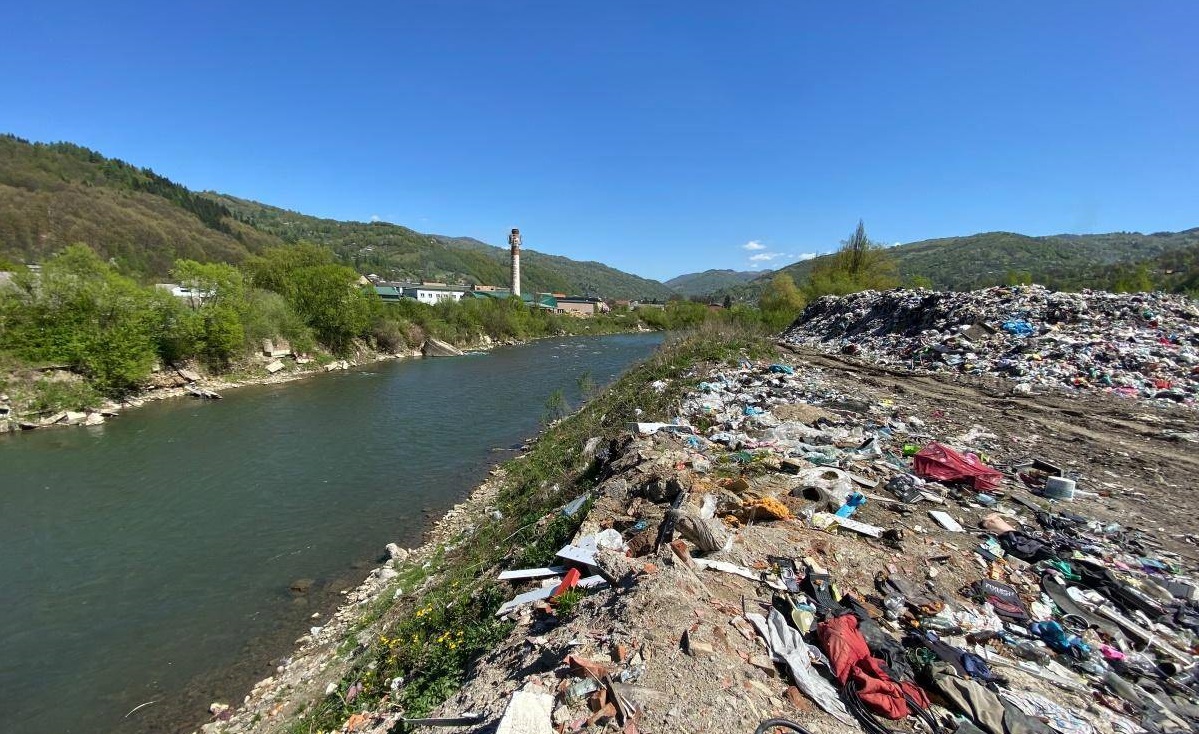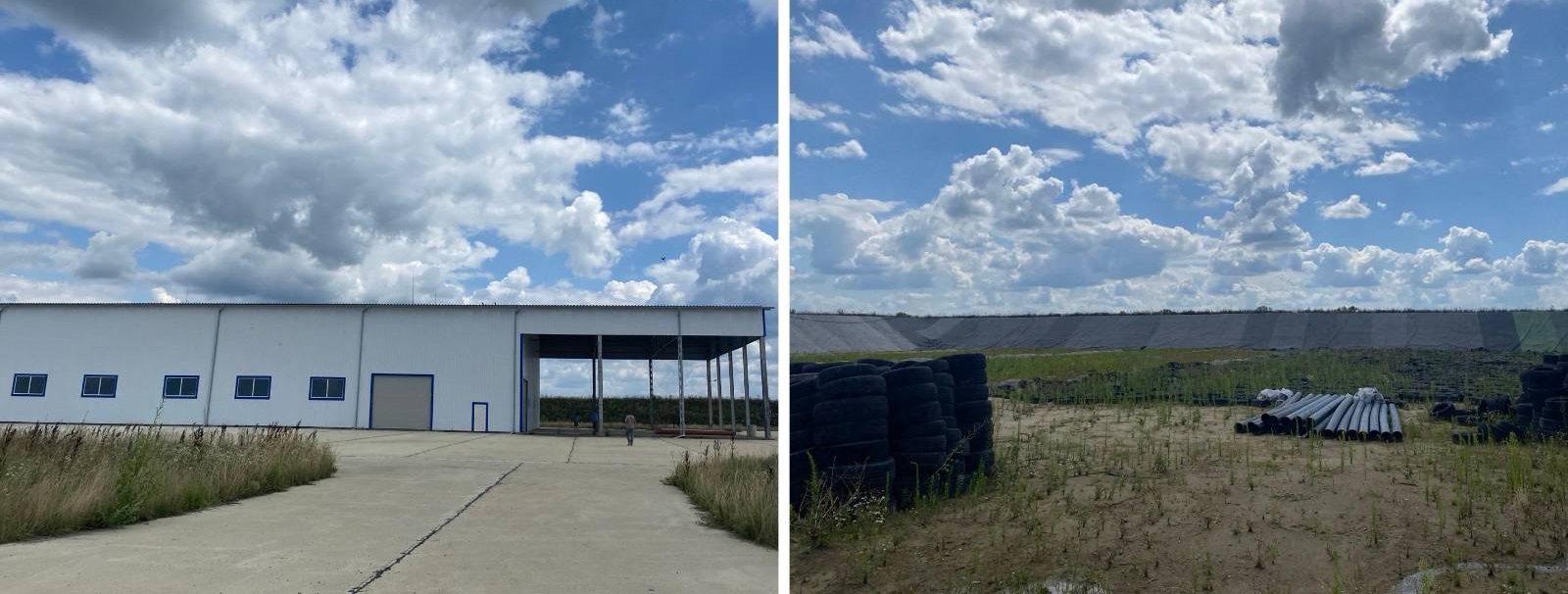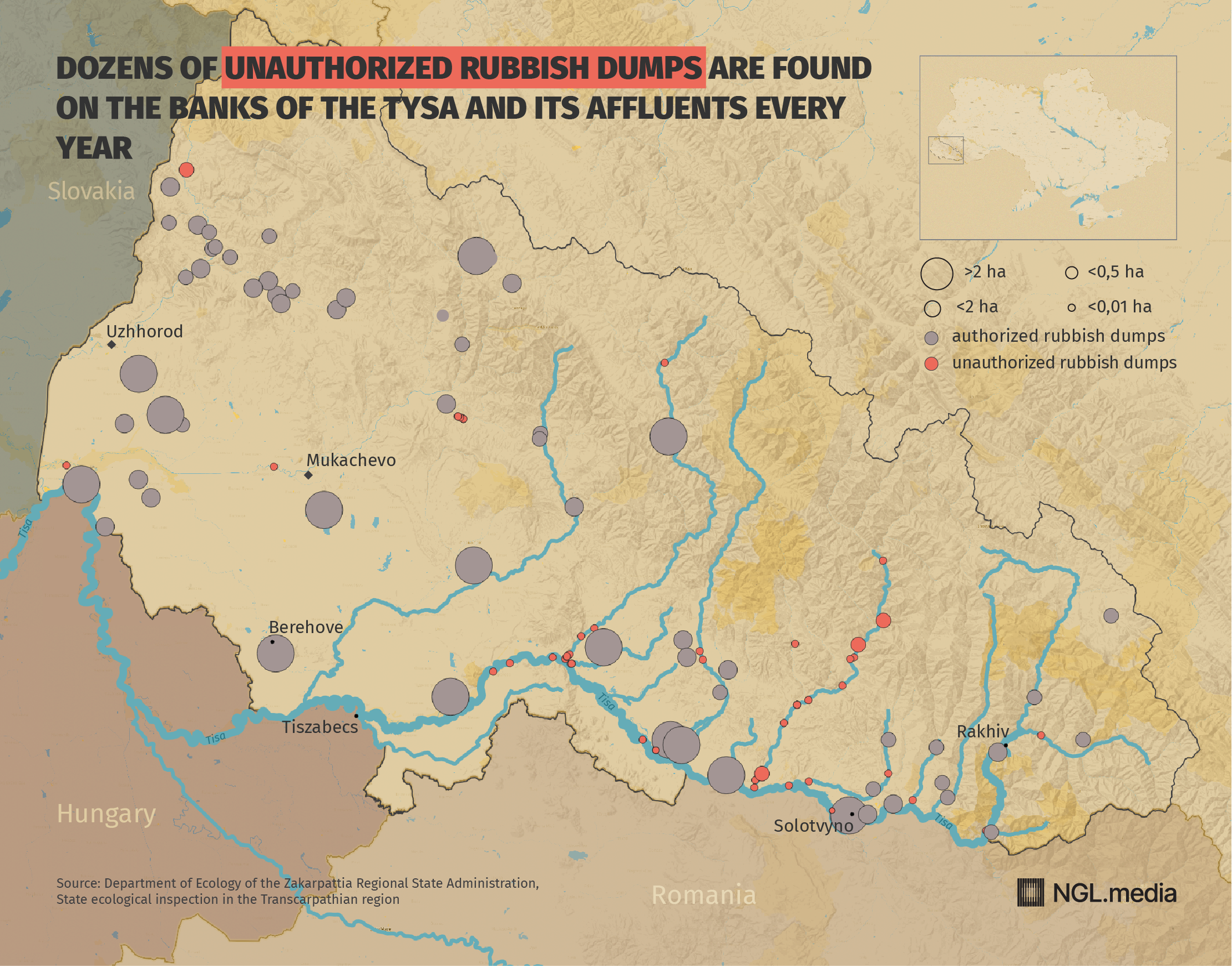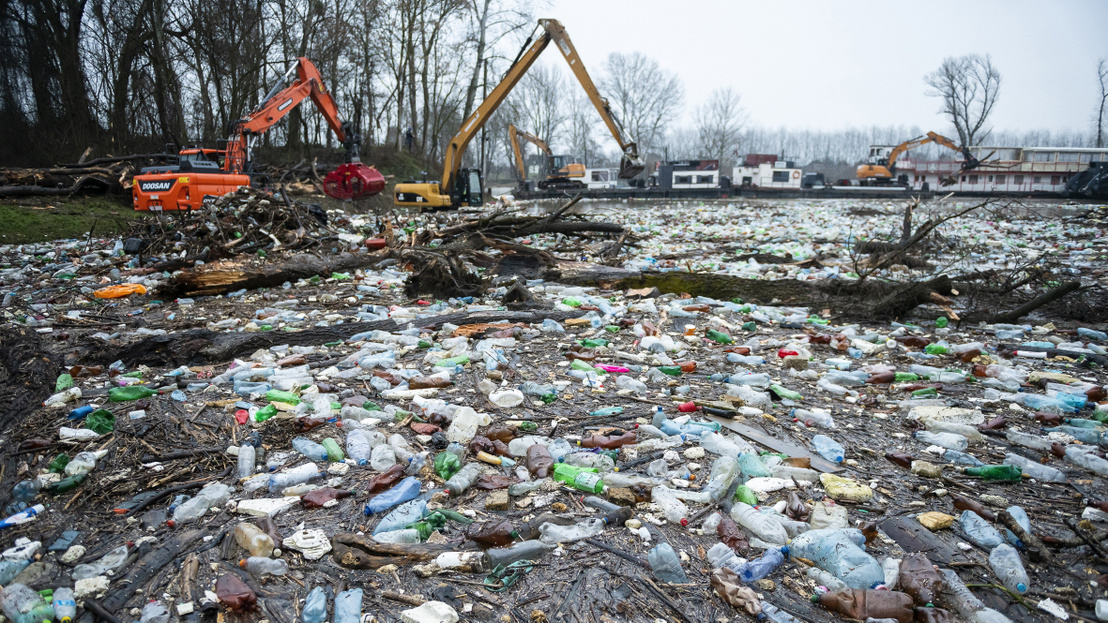In July 2020, the then-president of Hungary János Áder János Áder was the president of Hungary in 2012–2022 wrote personal letters to the presidents of Ukraine and Romania, asking them to prevent the pollution of the Tysa, the longest and one of the most important rivers in Hungary, with household rubbish. In Áder’s words, the problem is that the Tysa is filled with household rubbish, which gets into the river from the territory of Ukraine and Romania the length of the Tysa is Ukraine’s territory is about 200 km, 65 of which go along the Ukrainian-Romanian border.
“Our vehicles are no longer capable of dealing with heaps of rubbish, coming in uncontainable amounts,” Áder said, struck by the sight of the Tysa, completely covered with a “carpet” of plastic bottles, brought by floods from Ukraine and Romania.
“I felt so ashamed. Like someone filthified it, and I was asked to clean it up,” Oleksii Petrov, the then head of the Transcarpathian regional council, recollects his reaction to that letter.
In May 2021, Andrii Maliovanyi, the head of the Ukrainian State Ecological Inspection, referring to the results of the examination, conducted together with Hungarians, reported that only 20% of the rubbish, entering Hungary with the Tysa, is of Ukrainian origin. The rest comes from the Someș, the left tributary of the Tysa, which goes along the Romanian territory only.
Despite Maliovanyi’s assurances that Ukraine will take proper measures to decrease the flow of rubbish from its territory In particular, the head of the State Ecological Inspection promised to introduce the system of videomonitoring of the Tysa for timely detection of rubbish heaps in the river and to implement the system of rubbish collection and utilization in Transcarpathia, the situation got ever worse. In August 2021, the Hungarian ecoactivists collected 6 tons of rubbish near the border The rubbish was collected from the Tysa near the Hungarian border village of Tiszabecs, where the Ukrainian-Hungarian border along the Tysa starts, but a year later, they collected 15 tons in the same place. Actually, it was predominantly Ukrainian rubbish, since the Romanian river Someș, which brings its considerable contribution into polluting the Tysa, falls into it a few dozen kilometres down the stream.
One of the most evident explanations may lie in the fact that after the full-scale Russian invasion, about 400 thousand Ukrainians moved to the Transcarpathia, and the total number of the permanent population of the region increased by 30% in 2021, the population of the Transcarpathian region was 1.25 mln people.
The Tysa watershed covers the entire Transcarpathia, so to decrease the pollution, the entire region has to deal with its rubbish. Yet, it seems that nobody is ready to do it.
The journalists of NGL.media and the Hungarian investigative centre Atlatszo took a trip along the Tysa to understand how rubbish gets to its banks.
Rakhiv rubbish dump
Formally, the Tysa begins four kilometres above Rakhiv, after the conflux of the Chorna Tysa and the Bila Tysa. And Rakhiv is where the first rubbish dump is waiting. Strange as it is, this is an official rubbish dump, though it is located directly on the riverbank. The danger lies in the fact that during a flood, water can rise from one to five metres, and then it sweeps everything on its way. In these places, catastrophic floods occur approximately once in ten years, but water may rise considerably up to five times a year.
“We have been looking for an alternative to this rubbish dump since 2005. But we are living in the mountains, and there is no suitable place, so we still have to bring it here,” Yevhen Molnar, the acting mayor of Rakhiv, explained in the conversation with NGL.media.
The local community consists of about 23.5 thousand residents In addition to Rakhiv itself, the Rakhiv town territorial community also covers three neighbouring village councils. Two rubbish removal companies, a municipal and a private one, are working here, and between the two of them, they have 4,689 agreements for rubbish removal. It is not clear where the rest of the rubbish disappears.
Each household should have signed a separate agreement for rubbish removal, and the cost of the services depends on the number of residents – on average UAH 50 per person a month. However, according to Oleh Vahnahii, the director of “Ecobat Shuravi” LLC, which provides services to villages around Rakhiv, most people state only one resident of the house in their agreements to pay the least amount. His words are confirmed by Vasyl Slyvka, the director of the municipal “Rakhivkomunservis”, which works directly in Rakhiv. “It is very rare for people to state three people [in the agreement on rubbish removal], most of our agreements mention just one person. Now, we are cooperating with the Centre on the provision of administrative services, and we are asking them to give us the information on the ones, registered in apartments and houses. But it doesn’t give us much. The subscribers claim that they have gone abroad and will not pay,” Vasyl Slyvka explains.
The problems of the community with the removal and utilization of rubbish are typical for Transcarpathia, and they are not the worst ones. For instance, in the neighbouring Solotvyno community, also situated in the riverbed and on the banks of the Tysa, there are almost 35 thousand residents, but there are only 2,514 agreements on rubbish removal. In addition, Solotvyno is considered a popular recreation area, visited by tens of thousands of tourists each year.
Why pay if it is possible not to pay?
“Our clients pay about 50 hryvnia a month for rubbish removal. Yet, despite a low price, we have lots of refusals to prolong agreements,” Yevhen Molnar, the Rakhiv mayor, complains. “People say that they are going abroad and won’t pay. Although we know some cases when they are not leaving, they just don’t want to pay.
The mayor says that since the beginning of this year, about 20% of Rakhiv residents have refused centralized rubbish removal. And, in his words, the town council does not affect it.
Yet, the representatives of rubbish removal companies believe that it is the town authorities who should impact the residents. The Law “On Waste Disposal” states that all households have to execute agreements on rubbish removal. The absence of this agreement envisages a fine of UAH 340 to 1,360, but it doesn’t often happen in practice.
“The authorities don’t push or fine people because they want to stay in their positions after the next elections. When we apply to the tender on rubbish removal, they promise us thousands of clients. But when we start working, nobody actually wants to sign any agreements, and the authorities bury their heads in the sand,” the representative of a local rubbish removal company complains.
In some regions, there is actual cooperation between private companies and local authorities. “The most efficient way is a fine. For instance, we have our own database, and we can clearly say who has signed an agreement, and who hasn’t,” Volodymyr Kabai, the director of “AVE Mukachevo” LLC says. This company has been in the market for over 15 years. “We give the addresses of those enterprises and people, who don’t have a signed agreement on rubbish removal, to the municipal police, and they come to them with reminders. We provide services to ten communities, the average percentage of signed agreements is 70-90%.”
As for the Transcarpathian regional military administration, the entire responsibility is vested with the rubbish removal companies. “At first, they can inform or remind people, and after two months of ignoring, they have a right to go to the court,” Lidiia Avdeeva, a specialist in the Department of the housing and communal services and energy saving of the Transcarpathian RMA, advises.
The municipal company “Rakhivkomunservis” sued the residents, who refused to sign an agreement on rubbish removal, twice, and lost both times. “The judge ruled that people can make their own decision on how to deal with their rubbish. In our case, people wanted to burn it instead of removing. Then, we came to the conclusion that the court expenses bring only losses and will not do it again,” Vasyl Slyvka, the director of “Rakhivkomunservis”, says.
The mythical plant in Yanoshi
A complicated situation with rubbish disposal in Transcarpathia could have changed in 2012. That’s when the Yanoshi village council, which is a part of Berehovo community now, became the winner of the competition within the Program of the European Neighbourhood and Partnership Instrument, Hungary-Slovakia-Romania-Ukraine The program of border cooperation, “European Neighbourhood and Partnership Instrument” (ENPI) was implemented in 2007-2013, and among other things, it envisaged the cooperation between Ukraine and the EU members. Dozens of projects were implemented within its framework. The EU was the main donor. Yanoshi has obtained a grant of almost one million euros to build a plant for processing solid industrial waste, with a capacity of 30 thousand tons a year. At that time, Transcarpathia produced a total of about 300 thousand tons of rubbish a year.
It was supposed to be the first rubbish processing plant in the region. And in December 2015, the first priority line of the new plant was even officially opened with the participation of the then head of the Transcarpathian RMA, Hennadii Moskal. In reality, the plant hasn’t worked even one day, and as of September 2025, it hasn’t been commissioned yet.
It was later found that some money had been stolen, and the cost of the procured equipment had been overvalued considerably. At the beginning of 2016, the SSU initiated an investigation into the misappropriation of over UAH 3,5 mln, later the investigation was transferred to the police. As of 2025, no official suspicion has been announced in this case, according to the response of the Transcarpathian police to NGL.media’s inquiry.
The contractor of the grant project was “Bereh Vertikal”, responsible for the production of a “complex for selecting secondary materials” for a total amount of over UAH 4.32 mln. At the same time, according to the data of the Transcarpathian Trade and Commerce Chamber, referred to by the investigators, the actual cost of such a complex is UAH 500-800 thousand, which is six to eight times lower.
The founder of “Bereh Vertikal” LLC is a local entrepreneur, Mykola Yakymets, and two Hungarian joint stock companies – “Sekom” and “Vertikal”. In January 2022, the SSU reported that “Bereh Vertikal” LLC was involved in the formation of an illegal landfill with an area of five hectares of land in the Berehovo community. Despite these accusations, Yakymets’s company still wins tenders for rubbish removal in this community.
Zoltan Babiak, the head of the Berehovo community, says that every day, he receives complaints about the work of “Bereh Vertikal”, but he tries to solve them in cooperation with the company representatives. As for the investigation, in his words, he is waiting for the investigation results.
“We are aware that the cases are ongoing, and of course, we as local authorities have to cooperate and do cooperate with law enforcement bodies. In this case, we are interested in the final result, that is, a working plant. It is up to law enforcement bodies to look for the guilty party. If they need any assistance, we will provide it,” Zoltan Babiak said.
Mykola Yakymets refused to talk to NGL.media after the mention of the investigation into money embezzlement during the plant construction in Yanoshi. “I can only say that the line was commissioned in the test mode, and it worked, the officials checked it personally at the time. We are not responsible for its current state. It was the most competitive price at the time,” Mykola Yakymets said.
Yanoshi. Attempt No. 2
In 2022, the rubbish processing plant in Yanoshi got a second chance. Viktor Mykyta, the then head of the Transcarpathian RMA, claimed that the project could be completed successfully. They intended to complete arranging the sorting line within the new granting agreement for almost EUR 8 mln.
In July 2025, the journalists of NGL.media and Atlatszo visited the territory of this plant. At present, only one guard is working there. Using the money of the second grant, next to the hangar, where the sorting line is situated, they made a site for compressed waste burial, a shelter, and utility buildings. However, Zoltan Babiak says that it will definitely not work this year.
“This year, we expect to get documents on work completion. Then, we will carry out an examination and start working on developing the project to complete and commission the object,” he said.
Specificities of mountainous regions
According to the data, recently provided by the Transcarpathian RMA to NGL.media, as of 2025, 187,280 agreements on rubbish removal have been signed in the region, although there are over 350 thousand households in the region, not counting industrial and commercial enterprises.
In the opinion of Iryna Myronova, the expert in waste disposal, this situation is not specific to Transcarpathia only, it is common for mountainous areas and communities where people don’t live densely. “The closer people live to each other, the easier it is to remove their rubbish. It is vice versa in the mountains. In addition, such regions have an additional load from tourists. The households, hosting guests, should pay for rubbish removal as enterprises, but I suspect this is not what they do,” she believes.
Iryna Myronova highlights that only local authorities can change the situation with a low percentage of signed agreements. “The question is – how will these local authorities arrange this process? I know that some communities are creative, for instance, they remind people about obligatory signing agreements on rubbish removal when people come to them for some certificate or permits from the Centre on the provision of administrative services. Or the ones, who signed the agreement, receive their certificates sooner,” Myronova explains.
According to Yurii Shpontak, the director of the Department of ecology and natural resources of the Transcarpathian RMA, as of August 2025, 154 unauthorized rubbish dumps have been detected in the region. “78 of them were eliminated, and 76 still remain. The truth is also in the fact that people are most likely to repeatedly bring their rubbish to the place where the landfill has once located. So communities should trace it and prevent new pollutions,” he believes.
According to the State Ecological Inspection, since the beginning of the year, 18 unauthorized rubbish dumps have been found on the banks of the Tysa alone.
What happens on the other side of the border?
According to the official data, 98% of Hungarian households have signed agreements on rubbish removal and processing. In addition, they have to sort their rubbish. In 2023, the country introduced stricter norms of waste disposal, including the obligation for producers to take care of the collection and utilization of their packages.
“For instance, they introduced the return of plastic bottles to large supermarkets. In the supermarkets, they installed the machines, where people can put their PET bottles and aluminium cans and receive 12.5 euro cents per one bottle or can. It proved to be rather successful,” Orsolya Fülöp, a Hungarian journalist, says.
One of the most famous Hungarian ecological initiatives is PET Kupa It means “Plastic Cup” in Hungarian. The initiative is financed by the Hungarian government, and it also collects donations. The main aim of PET Kupa is the collection and utilization of plastic waste and other rubbish, which pollutes the Tysa. This initiative was started in 2013 in the form of competitions in cleaning the Tysa, supported by the then president János Áder, who loves water sports and fishing. Since then, there have been annual competitions, for which participants build vessels using plastic bottles, and then collect rubbish in the Tysa. Usually, PET Kupa holds its events near the Hungarian village of Tiszabecs, which is close to the Ukrainian border.
“In recent years, we have been collecting about 50-70 tons of rubbish a year. The main source of pollution occurs due to poor organization of the system of rubbish removal in the regions, situated on the banks of the Tysa, up the stream. According to our estimates, each year, in Transcarpathia, about 10 thousand tons of rubbish don’t get to the centralized system of solid waste removal,” Gregory Hankó, the expert in waste disposal and the project manager of PET Kupa, explains in the conversation with NGL.media. As per his estimates, over 1,600 tons of rubbish get accumulated in the Tysa riverbed each year.
PET Kupa and the Hungarian laboratory, Eurofins Environment Testing Hungary, regularly conduct the analysis of water in the Tysa. Each year, the specialists detect an increase in microplastic solid particles of synthetic polymers with the size in the range from 10-20 µm to 5 mm. This August, they identified 156 particles per one cubic meter of water, sampled in the Hungarian part of the Tysa. These particles affect the digestive system, the activity of the brain, and the reproductive ability of animals; besides, plant roots also release toxins.
According to the data of previous research by American scientists, microplastics in the fetal placenta have a direct effect on premature birth. Scientists say that small plastic particles enter our body from air, water, and food, and we can also consume them from hygiene means and clothes.
“We measured the rates of microplastics in Ukraine only in 2020 and 2021, but after 2022, I didn’t dare to go. But, on the Hungarian side, the average concentration of microplastics in water increased from 19 to 52 particles per one cubic metre. At the time, it meant that the Ukrainian part of the Tysa was moderately and, in some places, extremely polluted,” Timea Kish, a Hungarian researcher, told NGL.media.
The scientist compared the level of microplastic pollution in the Tysa to the Ganges, the Indian river, the riverbed of which is believed to be one of the most polluted in the world.
On the Ukrainian side, the analysis of water in the Tysa is conducted twice a year by the Basin authority of water resources in the Tysa subordinate to the State agency of water resources. Unfortunately, they don’t check it for the presence of microplastics, because they don’t have the required equipment, but, according to the data of the state laboratory, other indices are normal. In particular, it is confirmed by the recent analyses of water, sampled in August near the village of Solotvyno.
“During the last six years, the quality of water didn’t deteriorate; according to our data, it is in a stable good state. For instance, we check for ammonium, nitrates, and phosphates; all these indices are normal,” Karina Ihnat, the head of the laboratory of the State agency of water resources in Uzhhorod, told NGL.media.
Author Mariana Verbovska in cooperation with Orsolya Fülöp (Budapest), editor Oleh Onysko, map Nazar Tuziak, translation Nelya Plakhota, cover Viktoria Demchuk
This text was prepared thanks to the support from Journalismfund Europe






